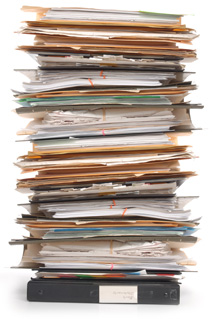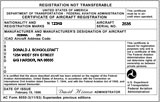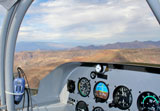|
Aircraft RecordsA review of the aircraft records is the usual starting point for a FAA Designated Airworthiness Representative (DAR) to evaluate the status of an aircraft and determine its eligibility for FAA certification. 1) The aircraft meets its type design, or properly altered condition; and 2) The aircraft is in a condition for safe operation. The above two conditions must exist to meet the FAA's definition of "airworthy". The following is a list of documents with a brief explanation of each. The FAA DAR will want to review these documents as applicable. 
The 8130-6 form is used to apply for a standard and special airworthiness certification, and the 8130-1 form is to apply for an export certification. 2. TYPE CERTIFICATE DATA SHEET. The type certificate data sheet (TCDS) is like a birth certificate, and provides a formal description of the aircraft, engine or propeller that has received type certification by the FAA. It lists limitations and information required for type certification including airspeed limits, weight limits, thrust limitations, etc. The FAA DAR will check this document for any specific notes related to the airworthiness certification and confirm that the aircraft serial number is listed.
Aircraft records showing previous certification history is useful in determining a baseline for the current certification. If the aircraft has been registered outside the United States, this information is useful in determining what records the FAA DAR will begin reviewing first. 4. EXPORT CERTIFICATE OF AIRWORTHINESS. If the aircraft was purchased from someone in another country or it is returning to the U.S. after being leased to an operator in a foreign country, there will usually be an export certificate of airworthiness issued by the foreign civil aviation authority. The foreign export airworthiness certificate is supposed to indicate that the aircraft meets the FAA requirements. But, unfortunately some countries aren't so knowledgeable about current FAA requirements and often these documents won't help the FAA DAR. In this case, for an aircraft manufactured in the United States, the original export certificate from the manufacturer would be used as the baseline. There are increasingly more bilateral agreements being formed between the United States and foreign countries for the reciprocal acceptance of export airworthiness certificates. Your FAA DAR will be familiar with these agreements and will advise accordingly. 5. PROOF OF DE-REGISTRATION. If the aircraft was previously registered in a foreign country, the FAA DAR will need to see proof in the aircraft records of deregistration. This is typically in the form of a telex or fax message from the foreign civil aviation authority to the FAA. An aircraft cannot be registered in two countries at the same time. 6. PROOF OF U.S. REGISTRATION. In the United States, the pink copy of the FAA Form 8050-1 can be used for this purpose. If the aircraft is located outside the United States, an official document (referred to as a fly-wire) issued by the FAA registration branch is usually needed to prove registration. Another acceptable method would be to search the
FAA registration database.
Typically these requirements are applicable to turbine engine powered or large reciprocating engine powered aircraft. If the aircraft has a U.S. type certificate and has not been substantially modified to the extent that there is an acoustical change, it meets the noise requirements of FAR 36. If the aircraft has been substantially modified or is foreign manufactured, a FAA DAR may have to involve FAA engineering in making a determination if it meets the requirements of FAR 36. 8. FUEL VENTING REQUIREMENTS. The fuel venting requirements of FAR 34 apply to aircraft with turbine engines. If an aircraft has a U.S. type certificate, it complies with this requirement. If the aircraft fuel system has been modified or the aircraft was not manufactured in the U.S., this requirement may need to be addressed before a certificate can be issued. 9. INTERIOR ARRANGEMENT AND EMERGENCY EQUIPMENT LIST. During the life of a larger aircraft, the interior configuration can be changed many times. Smaller aircraft will rarely see a seating configuration change. Aircraft records should exist that show the change to the configuration and that change must be FAA approved. If the interior has been altered since the aircraft was produced, a Supplemental Type Certificate (STC) or FAA From 8110-3 is the usual form of approval. A drawing called the “Layout of Passenger Accommodation” (LOPA) is referenced in the approval document. Usually as part of the LOPA is a drawing called the “Emergency Equipment Drawing”. This document shows the location and part number of all the emergency equipment required (by regulation) to be installed on the aircraft. The DAR will be looking for the approval document and conformity to the drawings as part of the aircraft records audit. 10. MATERIAL FLAMMABILITY CERTIFICATION. When an aircraft is built, the materials used in the interior and cargo compartments must meet the flammability requirements of FAR 25.853 (for large aircraft) or FAR 23.853 (for small aircraft). These regulations require materials to be fire resistant, which would allow passengers sufficient time to exit an aircraft in the event of a fire during an accident. If any of the seat covers, cushions, carpet, curtains, side wall panels, cargo liners, etc. have been changed, it is important that you obtain paperwork attesting to the materials compliance with the applicable regulations. 11. SUMMARY OF AIRCRAFT TIME IN SERVICE. From a review of the aircraft records, the FAA DAR must be able to determine the total time and cycles of the aircraft. There should be a record (computer print out, or log book) that shows the times and cycles in chronological order from zero hours and cycles until the current hours and cycles. 12. AIRWORTHINESS DIRECTIVES STATUS. A critical item in the aircraft records is the summary of airworthiness directives. The FAA issues airworthiness directives when a specific condition has been discovered to exist on an aircraft. If this condition is not corrected, the safety of the aircraft could be jeopardized. New AD's are published regularly and aircraft owners should be aware of the AD's applicable to their aircraft.
You can search for AD's related to your aircraft by clicking here.
An example of a summary sheet format can be found in advisory circular (AC) 43.9C Appendix 1. Click here to download a copy of AC 43.9C. In addition to the status summary, you should also have a copy of the actual document used to record the accomplishment of the AD as part of the aircraft records. This will have the date, method of compliance, and the name and signature of the person who performed the AD. 13. SERVICE BULLETIN STATUS. There should be a summary sheet showing the status of all manufacturers service bulletins (SB’s) incorporated on the aircraft. They should be listed in chronological order by SB number. In addition to the status summary, you should have the actual document used to record the accomplishment of the SB. 14. STRUCTURAL INSPECTION ITEMS STATUS. Supplemental Structural Inspections were mandated by the FAA for older large aircraft. This was done through the issuance of airworthiness directives that target certain principal structural elements of the aircraft. Most smaller aircraft do not have this requirement. Newer large aircraft include special structural inspections as part of their maintenance program. Aircraft records showing a status of when the inspections were last done and when they are next due would be all that is required for certification. 15. CERTIFICATION MAINTENANCE REQUIREMENTS. A Certification Maintenance Requirement (CMR) is a required periodic task, established during the design certification of the airplane as an operating limitation of the type certificate. CMR’s usually result from a formal, numerical analysis conducted to show compliance with catastrophic and hazardous failure conditions. A list of CMR’s required can be found in the manufacturer’s maintenance planning document, or other documentation referenced on the type certificate data sheet (TCDS). A summary sheet should be prepared and kept with the aircraft records that show when the CMR’s were accomplished and when they are next due. CMR's may not be applicable to small aircraft. 16. AIRWORTHINESS LIMITATIONS. Airworthiness Limitations (AWL) are an FAA approved means of introducing certain inspections or maintenance practices to prevent problems with certain systems. They can be in the form of an Airworthiness Limitation Instruction (ALI) or Critical Design Configuration Control Limitation (CDCCL). A list of AWL’s required can be found in the manufacturer’s maintenance planning document, or other documentation referenced on the type certificate data sheet (TCDS). A summary sheet should be prepared and kept with the aircraft records that show when the CMR’s were accomplished and when they are next due. AWL's may not be applicable to small aircraft. 17. INSTALLED COMPONENT LIST WITH CERTIFICATION TAGS. Each component that is installed on an aircraft after manufacturer should be from a known manufacturing source. The only way to prove this is to keep a copy of the airworthiness certification for that part in the aircraft records. This is typically a FAA Form 8130-3 or EASA Form One with a "dual release". The aircraft manufacturers certification of compliance (C of C) is also acceptable for a new part being installed. If the part was installed prior to the aircraft being on the U.S. registry, an ICAO member country’s certification is acceptable to include in the aircraft records. You should keep a list of all components changed and a copy of the certification document with the records. 18. HARD TIME COMPONENT STATUS WITH CERTIFICATION TAGS. The aircraft manufacturer will identify certain components that require a specific maintenance action (overhaul, inspection, test, etc.) at specified intervals. These components are referred to as hard time components. The recommended actions must be documented and a summary status of these components maintained in the aircraft records to track the date and time when the required action was last done and when it is next due. 19. LANDING GEAR OVERHAUL DATA AND LIFE LIMITED PARTS (LLP) STATUS. If the landing gear on your aircraft is required to be overhauled periodically, you must provide a copy of the last overhaul records. If there are life limited parts (parts requiring replacement at a certain time interval) installed in the landing gear, you must provide in the aircraft records a summary of the life limited parts installed. That summary must include the total cycles on the part and the cycles remaining until replacement. 20. ENGINE - SUMMARY DATA. You should have engine maintenance records to show the last overhaul of the engine, a summary status of airworthiness directives accomplished, and a summary status of any life limited parts installed in each engine to include the total hours and cycles and hours or cycles remaining until replacement. 21. AUXILIARY POWER UNIT (APU) - SUMMARY DATA. If your aircraft has an APU installed, you should have maintenance records to show the last overhaul of the APU, a summary status of airworthiness directives accomplished, and (if applicable) a summary status of any life limited parts installed in the APU to include the total hours and cycles and hours or cycles remaining until replacement.
22. REPAIR RECORDS. You must show in the aircraft records that any repairs performed on the aircraft were accomplished in compliance with FAA-approved data and that the aircraft conforms to its type design requirements. A manufacturers published repair data (structural repair manual) is considered FAA-approved data. If the repair is not a manufacturers published repair, it will require FAA approval. This is typically done by a DER on a FAA Form 8110-3. Large transport category aircraft being operated by an airline are surrounded by ground support equipment. This can result in dents and damage to the aircraft. A dent map is useful in showing the location and dimensions of each dent. Depending on the number of repairs that result from this damage, a repair map is useful in showing the location of each repair and makes it easier for the DAR to identify and review the supporting documentation. 23. ALTERATION RECORDS. You must show that any major alterations or modifications were accomplished in compliance with FAA-approved data and that the aircraft conforms to its type design requirements. Supplemental type certificates (STC), manufacturers service bulletins, or other data approved by the FAA on an FAA Form 8110-3 are examples of FAA-approved data. Keep in mind that you must have a right to use letter from the owner of the STC before it can be installed. 24. FLIGHT MANUAL Before an aircraft can be certificated, it must have an up-to-date approved flight manual (AFM) on-board. The aircraft manufacturer will be able to tell you what the latest revision level is. Also note that some modifications (i.e., avionics upgrades, STC's, etc.) affecting aircraft performance or flight characteristics will have flight manual supplement issued. Check to make sure all flight manual supplements are inserted in the AFM. 25. WEIGHT & BALANCE AND EQUIPMENT LIST As part of the original airworthiness certification, the aircraft is weighed to determine that the ranges of weight and center of gravity are within the approved limits, as specified in the appropriate aircraft specification or type certificate data sheet. There must be a current weight and balance report available for the aircraft to include an updated equipment list. The original equipment list produced by the aircraft manufacturer lists those items of equipment which are replaceable on the aircraft to include the weights and moment arms. This list should be amended as components are changed and kept current during the life of the aircraft. 26. INSPECTION PROGRAM STATUS Each inspection accomplished must be recorded in the aircraft records. A summary showing when each inspection was performed and when it is next due makes it easy to determine the status of the inspection program. Provide a copy of each record entry (release to service) for each major inspection. A recent inspection is required for standard and export airworthiness certification. The inspection should meet the requirements of FAR 43, Appendix D in scope and detail. Credit may be given for recent inspections performed in accordance with a continuous airworthiness maintenance program. This is up to the discretion of the FAA DAR. See the "Aircraft Inspections" section of this web site for more detailed information about the required inspections for certification.
|









